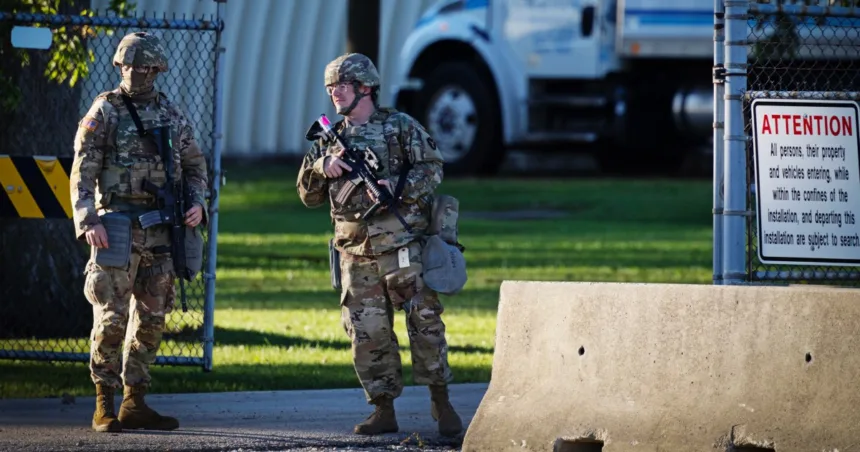President Donald Trump’s efforts to deploy National Guard troops in states that don’t want them will be tested in two different courts Thursday.
Lawyers for Chicago and Illinois will go before a federal judge to try to block troops from being deployed in the country’s third most populous city, while attorneys for Portland and Oregon will urge a federal appeals court to leave in place a restraining order against troop deployments there.
The hearings — in Chicago and San Francisco — are set to begin at noon ET in courthouses about 2,000 miles apart.
“We’re looking for the courts to do the right thing,” Illinois Gov. JB Pritzker, a Democrat, told reporters Wednesday.
Trump defended his actions in both states. “Everything we’re doing is very lawful. What they’re doing is not lawful,” he said at the White House later Wednesday.
Illinois sued Monday seeking to block the administration from deploying federalized National Guard troops on the streets of Chicago, contending it’s illegal, unconstitutional and unnecessary.
Trump ordered the deployment over the weekend. U.S. Northern Command said that 500 National Guard members have been mobilized — 300 from Illinois and 200 from Texas — and that some of the troops from Texas were on duty “in the greater Chicago area” as of Wednesday night.
“These forces will protect U.S. Immigration and Customs Enforcement and other U.S. Government personnel who are performing federal functions, including the enforcement of federal law, and to protect federal property,” Northern Command said in a statement.
The lawsuit argues that there’s no emergency in Chicago and that the administration has been trying to provoke unrest by increasing the presence of federal law agents who are using “unprecedented, brute force tactics for civil immigration enforcement.”
Those tactics include shooting “chemical munitions at groups that included media and legal observers” at an ICE facility outside Chicago and staging a dramatically produced raid at an apartment building in which agents rappelled down from Black Hawk helicopters.
“The community’s horror at these tactics and their significant consequences have resulted in entirely foreseeable protests,” the suit said.
“The deployment of federalized National Guard, including from another state, infringes on Illinois’s sovereignty and right to self-governance” and “will cause only more unrest,” it added.
The White House has maintained that Trump is trying to keep American cities and federal personnel safe. Trump said this week that if the courts wind up derailing his efforts to use the National Guard, he could invoke the Insurrection Act, which would empower him to use the U.S. military domestically.
“The Trump administration is committed to restoring law and order in American cities that are plagued by violence due to Democrat mismanagement. And President Trump will not stand by while violent rioters attack federal law enforcement officers,” White House spokeswoman Abigail Jackson said in a statement Wednesday.
The administration is expected to make similar arguments to a three-judge panel of the 9th U.S. Circuit of Appeals in San Francisco, which it’s asking to pause a federal judge’s order in Oregon over the weekend blocking the state’s National Guard from being federalized and deployed.
The “extraordinary” order by U.S. District Judge Karen Immergut “improperly impinges on the Commander in Chief’s supervision of military operations, countermands a military directive to officers in the field, and endangers federal personnel and property,” Justice Department attorneys contended in their court filing.
They also noted that the 9th Circuit blocked a similar restraining order this year involving National Guard troops in Los Angeles and held then that the president’s judgment about whether troops are needed should get “a great level of deference.”
Immergut, a Trump appointee, said in her order that the Portland case is different from the California one, in part because it appears Trump was acting in bad faith with his exaggerated claims of violence in the city, including that it was “war ravaged” with “ICE Facilities under siege from attack by Antifa” and “crazy people” who “try to burn down buildings, including federal buildings” every night.
While there had been some violent protests in June, demonstrations “were not significantly violent or disruptive in the days — or even weeks — leading up to the President’s directive on September 27,” Immergut wrote, describing the protests as mostly “small and uneventful.”
“On September 26, the eve of the President’s directive, law enforcement ‘observed approximately 8-15 people at any given time out front of ICE. Mostly sitting in lawn chairs and walking around. Energy was low, minimal activity,’” her order said.


Leave a Reply